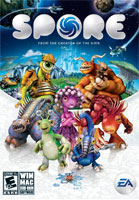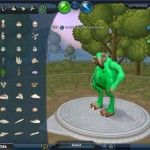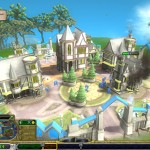Spore

Spore is the first of its kind for the simulation genre of video games. Playing this game takes you through the journey of being a small little cell fighting for survival slowly evolving into an actual creature that will allow you to create a tribe, civilization, and even as far as outreaching to space. I guess the sky isn’t the limit with this game.
The interface for Spore is very easy to use. A simple drag and drop interface is used for creating creatures and objects of all types. The possibilities are endless! When in a 3D world, normal WASD keys can be used to navigate as well as the mouse. The true test was to see if I could use WASD, Click-Navigation, and Mouse-Navigation — this game passes that test! You can use all 3 traditional navigation methods.
A big part of this game is the artificial intelligence. Your own creature has AI as well as your enemies and allies. One of the cool concepts I love about this game is your ability to make friends or foe. You  can approach another creature that knows nothing about you. If you sing to it, you can make friends. If you bite it, it’s going to bite back and be a foe. So what if there’s a creature that you approach that already doesn’t like you? Simple! You can either be mean to it and kill it off or you could be the better creature and make friends with it. How cool is that?
can approach another creature that knows nothing about you. If you sing to it, you can make friends. If you bite it, it’s going to bite back and be a foe. So what if there’s a creature that you approach that already doesn’t like you? Simple! You can either be mean to it and kill it off or you could be the better creature and make friends with it. How cool is that?
Along with the artificial intelligence, choice plays a big role in the game also. I don’t think you could possibly play the game and get the same outcome multiple times. For example, when you create your first creature you start out as either a herbivore or carnivore. If you select a carnivore creature and put a mouth that can filter feed plant organisms you can alter your diet habits into an omnivore. Another example is how your species is ranked. Is it a friendly species or is it a angry species? It all depends on how you interact with other creatures.
So how about those graphics? They’re pretty cool actually. There is a certain level of realism along with a  certain level of cartoony feeling. There are many different visual settings that you can set to really polish off the look of the game. The game even comes equipped with a depth of field and blur setting! That’s the first time I’ve ever seen those types of settings, personally.
certain level of cartoony feeling. There are many different visual settings that you can set to really polish off the look of the game. The game even comes equipped with a depth of field and blur setting! That’s the first time I’ve ever seen those types of settings, personally.
The animations used in this game have been a huge selling-point for it — even before the first screenshots were released. Each creature you create has procedural animation. What does this mean? Simply that, “your creatures and vehicles move based on how you construct them. They behave and interact based on your input and by their in-game encounters. That means there’s no pre-determined path you must follow; the game evolves based on your decisions.” It’s pretty cool seeing your creatures come to life as you create them. I can’t much explain this anymore; you’ll just have to play it to experience this one for yourself.
The music is very limited in this game — the most you hear is sound effects and voice sounds coming from the creatures you create. Creatures make a lot of vowel sounds. Lots of “Oohs”, “Aahs”, and “waka wakas.” I found this to actually be slightly annoying. There’s not many variations of these sounds so you hear them repeatedly over and over! It just makes me want to turn on my own music and mute the game completely. This is my personal opinion though.
Of course there’s online playing! Unlike most games, this one only connects to the servers to grab different creatures. So instead of playing in real-time with someone in California or Germany, you’re just playing the characters from other people in California or Germany for example. I really wish they would let us play in real-time, though.
Overall, I give this game a rating of 5/5 stars! The developers did a very nice job with this game and I was very impressed with it from the press release to the actual game-play.
FOR WINDOWS XP
* 2.0 GHz P4 processor or equivalent
* 512 MB RAM
* A 128 MB Video Card, with support for Pixel Shader 2.0
* At least 6 GB of hard drive space
FOR WINDOWS VISTA
* 2.0 GHz P4 processor or equivalent
* 768 MB RAM
* A 128 MB Video Card, with support for Pixel Shader 2.0
* At least 6 GB of hard drive space




